RBA Annual Conference – 1995 Productivity Change in the Australian Steel Industry: BHP Steel 1982–1995 Peter Demura[*]
1. Introduction
Productivity improvements are important in raising the nation's standard of living over the medium term. As Krugman (1994, p. 13) notes, ‘… productivity isn't everything, but in the long run it is almost everything’. Empirical research on trends and sources of Australian productivity growth have almost entirely been at the macroeconomic level (Dixon and McDonald 1991, 1992; NIEIR 1991; Adams, Dixon and Parmenter 1991) or at the aggregated industry level (Bureau of Industry Economics 1985; Hughes, Burgess and Dunlop 1991; Industry Commission 1992). However, there have been relatively few studies on identifying the productivity performance of individual firms (EPAC 1989; Lansley and Stern 1992). This is surprising given that ‘… productivity at the national level is no more than the sum of productivity achievements at the firm level – or even the individual production unit. Therefore, company productivity improvement is as much a critical issue as national productivity’ (Grossman 1984, p. 18). Moreover, accurate productivity measurement within a firm can provide management with an additional tool in analysing and correcting the efficiency of the firm beyond that provided by traditional accounting numbers (Kendrick and Creamer 1965; Cocks 1974).
In this paper, we attempt, in a small way, to extend the understanding of company productivity improvements in Australia with reference to productivity changes at BHP Steel. In particular, we examine the changes that have occurred since the early 1980s that have led to substantial improvements in labour productivity. An important driver of the improvement is the increased exposure to international markets through both exports and foreign direct investment. This extends the conclusions from earlier research (Ergas and Wright 1994) from the industry level to the firm level.
BHP Steel is a core business of Australia's largest publicly listed company, The Broken Hill Proprietary Company Limited (BHP). Other core businesses include minerals and petroleum. In 1993/94, BHP accounted for 1.4 per cent of Australia's GDP and 8.0 per cent of total merchandise exports (BHP 1994). BHP Steel is the world's 13th largest steel producer, accounting for 1.1 per cent of world production.
2. Measurement of Productivity
It is generally accepted that from a theoretical point, total-factor productivity (TFP) is a superior measure of productivity performance since it measures the efficiency of total resource use. In contrast, measures of partial productivity, fail to capture changes in other factors that lead to changes in productivity. For example, improvements in labour productivity may reflect changes in the capital/labour ratio as much as they reflect changes in the efficiency of labour. To produce meaningful measures of TFP, data need to be collected on the outputs produced and their respective prices, the various factor inputs and indirect taxes. As the number, complexity and geographical spread of products increases, the data requirements become onerous and the resultant measures may obscure underlying trends in productivity.
In the case of BHP Steel, measurement of TFP becomes a difficult exercise given:
- BHP Steel produces in excess of 10,000 products both in Australia and offshore (necessitating 10,000 plus deflators);
- the complexity of the cost and capital data required;
- the trend towards increased value-added production over the past decade; and
- the diversity of overseas operations.
Due to the complexity of the data requirements and the possibility of obscuring what is the essence of this paper, we focus on labour productivity improvements at the three Australian integrated steelworks which account for 88 per cent of production and about 47 per cent of labour employed by BHP Steel. The traditional measure of labour productivity at BHP Steel has been the amount of raw steel produced per steelworks employee. Benefits of the labour productivity measure are ease of calculation, compatibility and, although there have been quality improvements, the numerator (raw steel produced) is relatively homogenous.
3. Productivity Performance
Labour productivity at the three major Australian steelworks has risen from around 175 tonnes per annum in 1982 to 618 tonnes per annum in the year to May 1995 (Figure 1). This reverses the downward trend in productivity evident through the 1970s which resulted from an under-utilisation of capacity, a failure of employment to fall in line with production, industrial dispute, outdated work practices and a failure to gain the full productivity benefits of new capital investment (Steel Industry Advisory Council 1983). The contribution to measured labour-productivity improvements have varied from labour reductions to increases in production (see Table 1). The increase in productivity has been more pronounced in recent years, with productivity increasing by just over 80 per cent since 1991. Although the rise corresponds to the recovery in the Australian economy, the increase in productivity in the past two years cannot be simply attributed to an improvement in capacity utilisation since, over this period, steel production has remained at or above capacity after allowance for maintenance and other downtime.
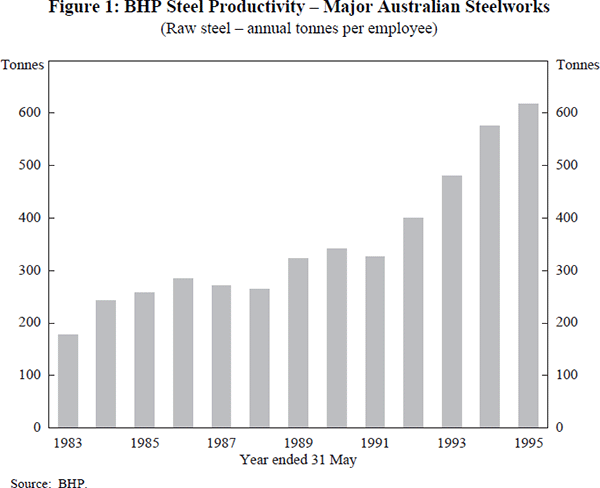
| Raw steel production % change |
Employment % change |
Productivity % change |
|
|---|---|---|---|
| 1982 | −8.3 | −4.3 | −6.2 |
| 1983 | −25.9 | −18.5 | −9.2 |
| 1984 | 13.3 | −17.8 | 36.5 |
| 1985 | 0.5 | −4.6 | 6.2 |
| 1986 | 7.9 | −2.1 | 10.5 |
| 1987 | −6.5 | 0.1 | −4.9 |
| 1988 | −6.6 | −6.0 | −2.2 |
| 1989 | 8.6 | −11.1 | 21.9 |
| 1990 | 0.5 | −5.1 | 5.9 |
| 1991 | −7.4 | −3.1 | −4.4 |
| 1992 | 8.7 | −11.2 | 22.3 |
| 1993 | 6.0 | −11.8 | 20.3 |
| 1994 | 14.1 | −4.6 | 19.5 |
| 1995 | 3.4 | −3.9 | 7.5 |
|
Source: BHP. |
|||
For a firm with large fixed costs, reductions in variable costs and improving productivity can have a significant impact on profitability. The increase in labour productivity, together with stronger demand and cost reductions, has made a major contribution to the improvement in BHP Steel profitability over this period, with profits increasing from a low of $189.5 million in 1991/92 to $670 million, excluding abnormal items, in 1994/95. Productivity improvements in a key sector such as steel do not only benefit the company involved, but also have positive effects on steel-using industries by lowering the cost of a key input and facilitating increases in production (Rimmer 1989).
4. International Comparisons
BHP Steel has not been alone in improving productivity performance during the 1980s and early 1990s. In Figure 2 we have plotted the labour productivity figures for the five most productive integrated steel companies in the world and BHP. This figure needs to be approached with a significant degree of caution because of the differing methods by which companies report productivity, the types of employees included (i.e. whether contractors, maintenance personnel, and non-production employees are included) and finally, differences in the degree of vertical integration and product range of the companies. All of these factors make international productivity comparisons difficult, especially between integrated steel makers and the minimills.
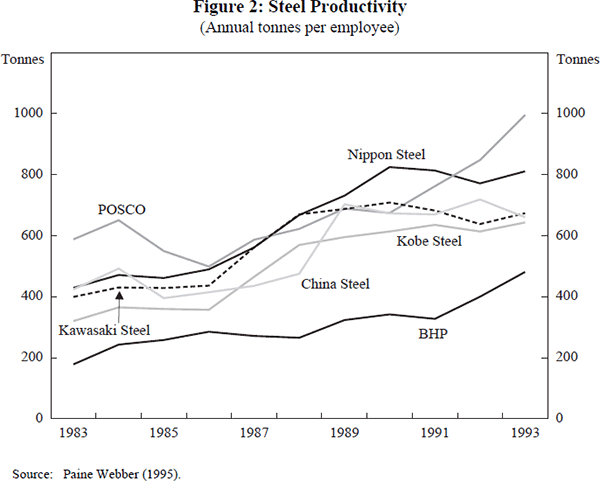
With the limitations in mind, we see that the South Korean steel maker (POSCO) had the highest level of productivity among the major integrated steel makers in 1993, followed closely by Japanese steel makers (Nippon Steel, Kawasaki Steel and Kobe Steel) and a Taiwanese steel maker (China Steel). However, these productivity figures pale into insignificance compared with the productivity of the minimill producers using electric arc technology (Paine Webber 1995).[1] The distinction between integrated and minimill producers is becoming increasingly blurred as the former adopt the new technologies and the quality of the steel from the minimills improves. Even the integrated steel makers in our comparison, with the exception of China Steel, have some degree of electric arc capacity.
It is evident that, in recent years, BHP Steel has narrowed the gap between itself and the world's best which, with the exception of POSCO, is around 700–800 tonnes per employee. Over the period 1983–93, BHP Steel productivity grew at an annual compound rate of 9.5 per cent, the fastest rate of growth of any of the major steel makers and almost 50 per cent higher than the industrial world average (Figure 3). In absolute terms, productivity at BHP Steel in 1983 was only 30 per cent of the prevailing world best (POSCO) but, a decade later, this had risen to just under 50 per cent of this level. Given the significant increases in labour productivity since 1993, the gap is likely to have narrowed further. Just as developing economies approach the productivity levels of more developed economies over time, through the introduction of new technology and improved labour skills, the same pattern of convergence and catch-up may be underway in the world steel industry.

5. Response to a Crisis
The first big push to improve productivity came in the early 1980s when a confluence of forces threatened the existence of one or more of BHP's steelworks. During the early 1980s the world recession, falling demand and an increase of excess world steel capacity, estimated at 30 times Australian domestic consumption (Walsh 1982), resulted in a substantial increase in imports of cheap steel into the Australian domestic market. This occurred at the end of the resources boom, and BHP Steel found itself with excess capacity, both plant and labour, and a declining market share. BHP's immediate response was a downsizing of operations. Between 1982 and early 1983 plant capacity was reduced by one third to 6.0 million tonnes (Prescott and McLeod 1990) and the workforce declined by almost 10,000 either through voluntary retirement or retrenchment (Steel Industry Advisory Council 1983) (Figure 4).
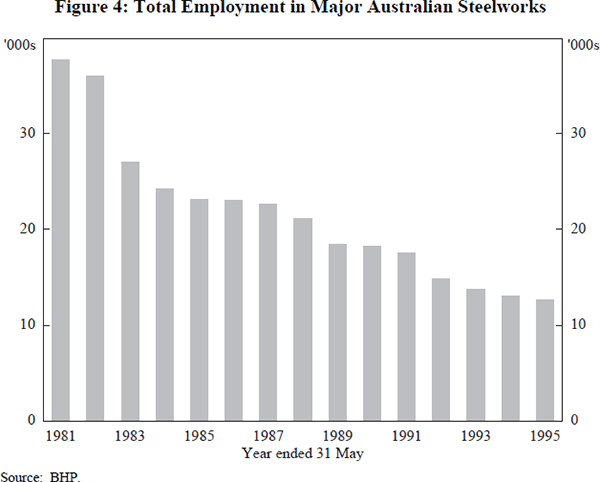
The crisis in the steel industry focused BHP's attention on the need to increase productivity and modernise its steel-making operations. After a succession of industry inquiries and a change of government, BHP together with unions and Federal and State governments agreed to the Steel Industry Plan. Under the Plan, BHP gave an undertaking to maintain its steel-making capacity, invest $800 million over five years and refrain from further compulsory retrenchments. Governments, on the other hand, promised up to $71.2 million in bounties (not required), and committed to reduce indirect taxes, speed up anti-dumping provisions and review assistance measures if required (Capling and Galligan 1992). The unions agreed to productivity targets, to follow dispute settlement procedures and refrain from seeking increases in wages in excess of community standards (Prescott and McLeod 1990).
By 1984, productivity at the steelworks had reached 243 tonnes per year and the net operating loss was substantially reduced. There is some debate about the role of the Steel Industry Plan in turning BHP Steel around (Capling and Galligan 1992). For example, the Bureau of Industry Economics argued that the turnaround had more to do with currency depreciation, recovery from the 1982/83 recession, cost cutting and retrenchments implemented prior to the Plan, and an improved industrial relations climate under the Accord (Bureau of Industry Economics 1989). However, what the Plan did do was allow BHP Steel to restructure its operations, increase training and development and give it confidence to undertake substantial capital investments with the aim of improving business performance. Rather than investing $800 million, it spent almost $2 billion. This represented the ‘… largest capital expenditure program, on a per tonne of capacity basis, of any developed steel-making country – surpassing Japan, doubling EEC spending, and quadrupling that in the US’ (Prescott and McLeod 1990, p. 2).
6. Beyond the Crisis: Focus on Growth, People and Labour – Management Relations
The Steel Plan marked the beginning of a cultural change within BHP Steel, and this carried over into the Steel Industry Development Program Agreement (SIDA) in 1989 when the Steel Industry Plan ended. Under SIDA, the focus on business improvement and productivity performance continued with management and unions agreeing to performance targets and on the processes for identifying and implementing measures to achieve the targets. Key measures for increasing productivity were job restructuring, increasing the skills of the workforce, the implementation of total quality management (TQM) and encouraging, at all levels, a more customer-oriented and productive culture than had existed previously. Consultative arrangements were put in place, career and training opportunities were developed, and award restructuring was undertaken. During this period, the emphasis was on improving the skills of employees to enable them to keep pace with the technological changes occurring in the steel-making process, and to broaden the range of tasks an employee could be asked to perform (Morrissey, Dibden and Mitchell 1992). An important element in achieving the required changes was the guarantee of continued employment, but not necessarily the same job, as this might have been made redundant through restructuring.
The momentum generated under SIDA has been carried forward into the new employee/management agreement, the National Steel Industry Business Improvement Agreement (SIBI). As the name suggests, the focus is on business improvement, particularly at the local work level. Using the framework developed under TQM, a system of continuous improvement is creating an environment of change where employees are encouraged to develop ways to improve the efficiency of their work areas. In addition, employees are shifting from a production-based culture to a customer focus. The emphasis is no longer on reducing the number of people, but rather on equipping the workforce with a set of common objectives, skills and flexibility to respond to change.
Improvements under SIBI have come from a better organisation of work – anecdotes abound about the type and value of the improvements made to date, but perhaps the most significant are the improvements at the slabmaking operations at the Port Kembla steelworks. For several years, the slabmaking operations were unable to lift output beyond 3.6 million tonnes per annum despite significant effort and capital investment. There was also room for improvement in both delivery times and quality. However, over a period of two years the output of steel slabs increased by 25 per cent to 4.5 million tonnes per annum while at the same time quality and delivery performance improved. In fact, as Paul Jeans, the General Manager of the Slab and Plate Products Division noted, ‘the major improvements at … Port Kembla were achieved by and through people’ (Jeans 1995). This resulted from a process which included:
- a re-organisation of the steel-making and slabcasting departments;
- the development of shared goals and objectives;
- an involvement of all workers in the collection and analysis of data and identification of possible areas of improvement;
- training and developing the skill base through multi-skilling;
- the development and measurement of key performance indicators; and
- feedback and recognition of a job well done.
The improvements at the slabmaking operation highlight the value of learning and reducing confusion through systematic analysis in improving productivity. By being involved, workers and management gained valuable knowledge in the operations of the capital equipment but, of equal importance, they gained an appreciation of the process by which improvements were made enabling applications elsewhere in the plant. Hayes and Clark (1986) note that the rate at which managers and employees learn, and in turn gain a better understanding of the manufacturing process, is a potential source of faster productivity growth.
The gains made at Port Kembla, and elsewhere within BHP Steel, reflect a conscious attempt to involve all employees in process improvement. A number of things facilitate this policy of inclusion. First, communication between management and employees has been improved, thus avoiding some of the problems evident in the earlier restructurings (Capling and Galligan 1992). Second, there has been a de-layering of management structures which has improved communications. Third, employees remain focused through the development and implementation of business plans. Fourth, the guarantee of employment during the life of SIBI has reduced suspicions that changes will lead to widespread unemployment. Finally, there have been financial rewards by way of quarterly performance-based bonuses, while the introduction of the Employee Share Plan has given employees a direct stake in the prosperity of the steel business and the company as a whole.
7. Labour Disputes and Safety
Improvements in labour productivity have also come from the dramatic reduction in the number of employee hours lost in industrial disputes: lost employee hours as a share of total hours worked are now less than one-fifth the level that prevailed in 1983. The improvement in labour relations can be put down to better working conditions, greater employment security, the various Accords between the government and trade unions and a reduction in demarcation disputes following the restructuring of awards. An additional element has been the improvement in management/employee communications. As well as these positive developments, the recent decline in labour time lost at BHP Steel mirrors that of the Australian economy; undoubtedly the recession reduced the willingness of employees to take industrial action.
BHP Steel is looking at making large improvements in safety, with the ultimate target being zero lost time injuries (LTIs), while the interim target is a 50 per cent reduction in the number of LTIs by 1996 and a 70 per cent reduction by 1999. Apart from the obvious benefits, improvements in safety are leading to increased productivity through reductions in absenteeism and better morale among employees. BHP Steel has the objective to be a world-class performer in terms of safety and has developed a range of policies to achieve this objective.
8. The Role of Internationalisation
In a paper presented to this conference last year, Ergas and Wright (1994) discussed the positive benefits a greater involvement in international markets can have for firm performance and productivity. The conclusions reached by Ergas and Wright suggest that internationalisation begins a process of innovation where firms look to improve their work and management practices, technology, products and quality and marketing in order to prosper from the increased competition.
Increased international exposure has influenced productivity at BHP Steel through three main channels: economies of scale; the increased attention of management and employees in addressing inefficiencies; and the development of high quality export-oriented products.
However, for BHP Steel to achieve the necessary economies of scale and increase the size of the steel business at a time when Australian consumption was growing slowly, it was necessary to develop export markets for both domestic and foreign value-added products (see Figure 5). By developing markets outside Australia, BHP Steel in recent years has been able to maintain maximum capacity utilisation, thereby promoting gains in labour productivity and substantially reducing its average fixed costs. This would not have been possible if it had remained a domestic producer.
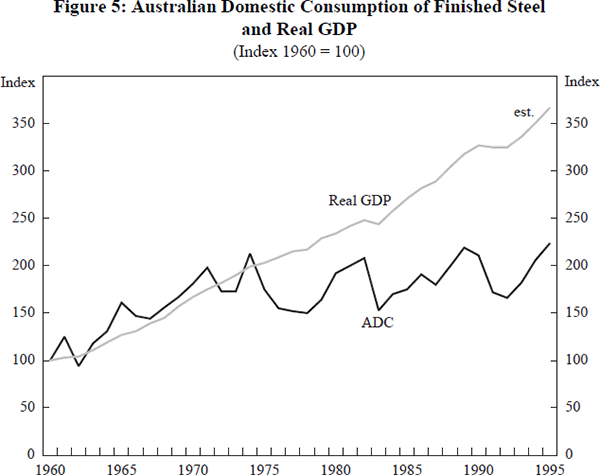
Moreover, as a result of the success of BHP Steel in overseas markets, an increasing share of capital improvements are being devoted to servicing export markets, as shown in Figure 6 (Prescott and McLeod 1990). In this instance, the causation runs from exports to productivity. To remain competitive in export markets, BHP Steel has had to make productivity improvements by addressing all the inefficient work practices, inappropriate manning levels, cost structures and labour relations practices. This has been going on for over a decade and employees are now more aware of the threats from competition both in export markets and from imports into the domestic market.
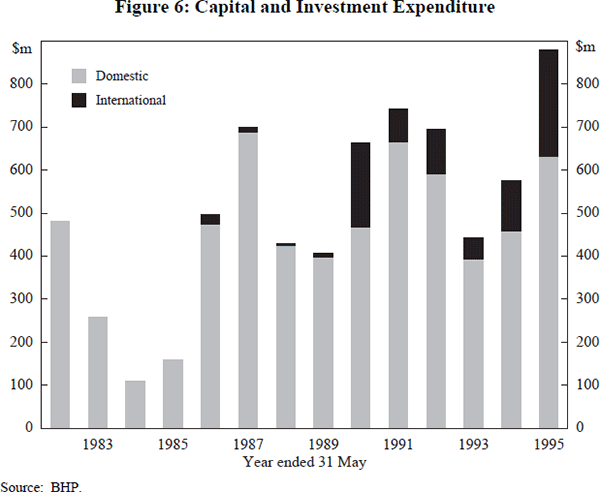
The final factor has been the improvement in quality and the increasing range of products exported. BHP Steel has always exported a large percentage of production, but what has changed is the increase in the value added of its exports. In effect BHP Steel has shifted from an opportunistic exporter to one which makes exports the focus of attention (AMC 1990). Initially, exports were marginal and variable, capacity was primarily to serve the domestic market; and investment in downstream activities was neglected. Now, like other export-oriented firms, BHP factors exports into capacity expansion, develops export markets for the long term, invests in foreign marketing offices and distribution, gathers market intelligence, and modifies the products to suit foreign customer requirements. In fact, BHP Steel is unique in that it has one of the highest export/production shares of any major steel maker in the world. There is little doubt that the development of a viable export business has acted as a catalyst and provided BHP Steel the opportunity to restructure its operations to enhance productivity.
9. Investment in Technology
Apart from the ongoing business improvement program, the development of export markets and improved labour relations, the final major influence on productivity performance has been the introduction of new technology. Moreover, the latest developments in technology probably offer the greatest potential to further increase productivity. BHP Steel has continued to invest heavily in new technology over the past decade or so and has aimed to replace outmoded methods of steel production with technology best suited to its operations.
The continued expansion of capital and the reduction in the number of employees suggest that there has been a substantial increase in the capital/labour ratio. This trend is likely to continue and apart from the business improvement program, the next jump in productivity will probably come from technological improvements which eliminate or combine some of the steps in the steel-making process. The most well known of these is the minimill, which essentially produces steel from scrap, or alternative iron inputs, doing away with the front-end process of the steelworks.
In fact, there exist ambitious projects that aim to eliminate almost all rolling stages prior to the formation of thin sheet products. These developments, if successful, will radically change the economics of steel production. In the interim, however, conventional integrated blast furnace plants remain the choice where scale economies can be achieved and the best of these plants, including BHP's Port Kembla steelworks, remain cost competitive with the minimill operations.
10. Conclusion
Initial attempts at improving productivity at BHP Steel were driven by a crisis which threatened the survival of some, if not all, of the business. Once the decision was made to sustain productivity improvements, labour numbers were reduced and investment increased. Both management and employees worked to improve business performance, motivated by the desire to succeed in export markets. In fact, this export orientation has been accompanied by a change of mindset, with the customer (increasingly an international customer) becoming the prime focus. Productivity improvements will continue. This will be dictated by pressure from competition, both at home and offshore. Although, the major improvements in productivity will be facilitated by the introduction of new technology, an essential element in the improvement will be, as in the past, the development of BHP's people.
Footnotes
The author acknowledges the considerable assistance from Ross McDonald, Geoff Shaw and other colleagues from BHP Steel. The views expressed in this paper, are those of the author and are not necessarily those of The Broken Hill Proprietary Company Limited. [*]
Where as much as 2,609 tonnes per annum has been produced by Tokyo Steel and 1,360 tonnes per annum by the US steel producer, Nucor. [1]
References
Adams P.D., P.B. Dixon and B.R. Parmenter (1991), ‘Productivity Improvements and Foreign Debt Stabilisation’, in EPAC, Sources and Effects of Productivity Growth, Background Paper No. 8, AGPS, Canberra, pp. 1–19.
Australian Manufacturing Council (AMC) (1990), The Global Challenge – Australian Manufacturing in the 1990s, Australian Manufacturing Council, Melbourne.
BHP (1994), BHP in Perspective.
Bureau of Industry Economics (1985), ‘Productivity Growth in Australian Manufacturing Industry’, Information Bulletin No. 8, AGPS, Canberra.
Bureau of Industry Economics (1989), ‘Australian Steel Industry Plan’, Occasional Paper No. 5, AGPS, Canberra.
Capling, A. and B. Galligan (1992), Beyond the Protective State, Cambridge University Press, Melbourne.
Cocks, D. (1974), ‘The Measurement of Total Factor Productivity for a Large US Manufacturing Corporation’, Business Economics, IX, pp. 7–20.
Dixon, P.B. and D. McDonald (1991), ‘Labour Productivity in Australia: 1970–71 to 1989–90’, in EPAC, Sources and Effects of Productivity Growth, Background Paper No. 8, AGPS, Canberra, pp. 1–72.
Dixon, P.B. and D. McDonald (1992), ‘A Decomposition of Changes in Labour Productivity in Australia: 1970–71 to 1989–90’, Economic Record, 62 (201), pp. 105–117.
EPAC (1989), Productivity Studies in Australia: Results of Recent Studies, Council Paper No. 39, AGPS, Canberra, pp. 51–106.
Ergas, H. and M. Wright (1994), ‘Internationalisation, Firm Conduct and Productivity’, in P. Lowe and J. Dwyer (eds), International Integration of the Australian Economy, Reserve Bank of Australia, Sydney.
Grossman, E.S. (1984), ‘Company Productivity Measurement’, Business Economics, XIX(4), pp. 18–23.
Hayes, R.H. and K.B. Clark (1986), ‘Why Some Factories are More Productive Than Others’, Harvard Business Review, September-October, pp. 66–73.
Hughes, B., J. Burgess and W. Dunlop (1991), ‘Neo-Classical Formulations of Productivity Growth in Manufacturing’, in C. Hamilton (ed.), The Economic Dynamics of Australian Industry, Allen and Unwin, Sydney, pp. 79–99.
Industry Commission (1992), Annual Report 1991/92, AGPS, Canberra.
Jeans, P. (1995), ‘Measuring Organisational Performance – A Case Study’, paper presented at Australian Quality Council, 8th National Quality Management Conference, Sydney, 9–11 April.
Kendrick, J.W. and D. Creamer (1965), ‘Measuring Company Productivity’, in Handbook with Case Studies, The National Industrial Conference Board, New York.
Krugman, P. (1994), The Age of Diminished Expectations, The MIT Press, Cambridge, Massachusetts.
Lansley, D. and C. Stern (1992), The Productivity Drive – A Survey of 18 Companies, McIntosh and Company Limited, Melbourne.
Morrissey, M., M. Dibden and C. Mitchell (1992), Immigration and Industry Restructuring in the Illawarra, Bureau of Immigration Research, AGPS, Canberra.
National Institute of Economic and Industry Research (NIEIR)(1991), ‘Distributing the Gains from Enhanced Labour Productivity: Macroeconomic Implications of Alternative Scenarios’, EPAC Background Paper No. 12, AGPS, Canberra.
Paine Webber (1995), World Steel Dynamics, Paine Webber, New York.
Prescott, J.B. and A. McLeod (1990), ‘BHP Steel in the 1990s – International Success Through People’, EPAC Discussion Paper No. 1, AGPS, Canberra.
Rimmer, R. (1989), ‘Employment Implications of Improved Labour Productivity in the Australian Iron and Steel Industry’, Economic Record, 65(189), pp. 114–125.
Steel Industry Advisory Council (1983), Report of the Steel Industry Advisory Council, AGPS, Canberra.
Walsh, M. (1982), ‘BHP's Threat: We'll Close the Steel Industry’, The Bulletin, 21–28 December, pp. 20–23.